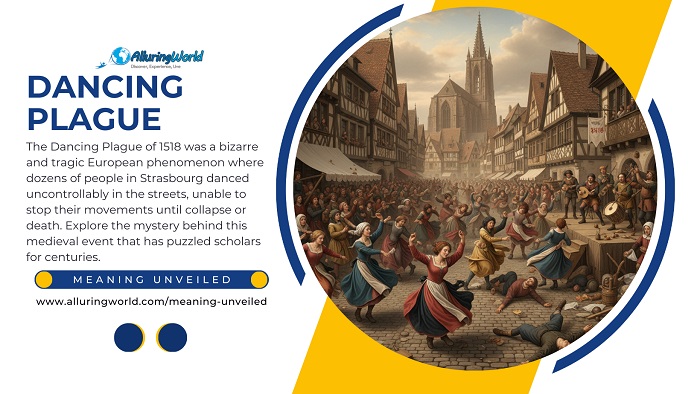Read time ca. 5 minutes
There are many unusual events throughout European history; however, among the most unusual ones is the Dancing Plague of 1518, which was a strange and tragic phenomenon that occurred in Strasbourg, then part of the Holy Roman Empire. Over the course of several weeks, reports of dozens of people have been given as they have danced uncontrollably in the city’s streets, unable to stop their movements until exhaustion, collapse, or even death. This was quite a bizarre occurrence, which has puzzled scholars for centuries. Even today, there are no official reasons for why this happened, and its causes shall remain uncertain, while its consequences continue to spark debate. Examining this episode provides insight into the fragile balance of health, society, and belief in the late medieval world.
The Outbreak Begins:
The phenomenon started in July 1518 when a woman named Frau Troffea stepped into the streets of Strasbourg and started dancing with no apparent reason. According to accounts, she moved tirelessly for days, showing no sign of being able to control her movements. Within a week, dozens of others had joined her, and the number of dancers steadily increased. According to some contemporary estimates, there might have been between 50 and 400 individuals who may have eventually been affected. What made this outbreak particularly disturbing was that the participants seemed compelled to continue despite exhaustion, and in some cases, death from heart failure, stroke, or extreme fatigue was reported. There are no official numbers that could be confirmed about the number of deaths that occurred from this outbreak, although some sources estimate hundreds, but others, like the city’s contemporary records, do not mention any fatalities.
Authorities’ Response:
Even the city’s leaders were bewildered by this weird but very intriguing spectacle. Believing that the dancers were afflicted by a form of illness rather than possession or witchcraft, local magistrates sought to provide what they thought was an appropriate remedy. As the first step would have been to ban the activity, the city’s leaders instead arranged for spaces where dancing could take place more freely, and they even hired musicians to accompany the participants. The hope was that by allowing the afflicted to dance until the compulsion ended, the crisis would resolve itself. Far from helping, this decision may have worsened the outbreak, prolonging the ordeal and spreading the frenzy to larger crowds.
Medical Explanations:
In the centuries that followed, historians and physicians have put forward numerous theories to explain the dancing plague. One widely discussed explanation is ergot poisoning, caused by consuming bread made from rye contaminated with a toxic fungus. Ergot can produce hallucinations, convulsions, and spasms, but many scholars argue that it would not account for the highly coordinated, rhythmic dancing reported.
Another hypothesis suggests mass hysteria, known today as mass psychogenic illness. Under this interpretation, the outbreak reflected the extreme psychological stress of the period. Since Strasbourg’s residents faced famine, disease, and religious turmoil, the dancing could have been an outlet for collective anxiety that was accumulating throughout the years. This theory is perhaps more aligned with the broader cultural context, despite people in the region maintaining strong beliefs in curses, divine punishment, and supernatural intervention.
ADVERTISEMENT
Religious and Cultural Factors:
As it happened during medieval times, the worldview often linked unusual events to spiritual causes. During these medieval times, there were people who believed that the dancers were cursed by Saint Vitus, who was a Christian martyr associated with movement disorders and neurological conditions. Pilgrimages and rituals dedicated to him were common in the region, and it is possible that cultural expectations reinforced the outbreak, leading people to interpret their symptoms through a religious lens. The strong role of faith in daily life created conditions where fear of divine retribution translated into physical expression.
Historical Documentation:
There are not that many sources which would point to the Dancing Plague of 1518, and this mostly comes from chronicles, local records, and medical accounts of the era. These descriptions, while valuable, must be read with caution, as exaggeration and interpretation through the beliefs of the time may have shaped the narrative. Nonetheless, as information was gathered from multiple sources, it confirms that a significant event took place during this period of time, and it was one that affected the whole community.
Legacy and Modern Interest:
Even today, the Dancing Plague has remained a subject of fascination for historians, medical researchers, and cultural commentators. Due to the intriguing nature, people are trying to find the complex relationship between body and mind, as well as the influence of environment and belief systems on human behavior. Since the exact cause is still debated and there are different interpretations, the episode serves as a reminder of how communities once coped with unexplained phenomena and how fear, faith, and stress could manifest in extraordinary ways.
The event also continues to inspire modern culture, appearing in books, academic studies, and artistic interpretations. Overall, this unique event serves as a metaphor for how societies respond to crises, to discover how fragile human health can be, and the mysterious aspects of collective behavior.
Conclusion:
In conclusion, the 1518 Dancing Plague is still considered one of the most enigmatic events in European history. As it started with just a single woman and spread to other individuals, it brought an entire city to confront the limits of medical knowledge, cultural belief, and human endurance. We might never know what the causes are for people to dance, whether that be by ergot poisoning, psychological distress, or spiritual fear; the outbreak demonstrates how interconnected society, faith, and health were in the medieval period. Even if many centuries have passed, its legacy continues to intrigue and challenge our understanding of the human condition.

